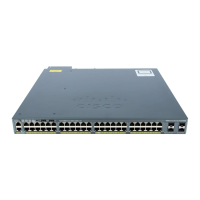the downstream switch immediately sends proxy reports for all the learned groups on this port without waiting
for a general query.
Leaking IGMP Reports
To achieve multicast traffic convergence with minimal loss, a redundant data path must be set up before the
Flex Links active link goes down. This can be achieved by leaking only IGMP report packets on the Flex
Links backup link. These leaked IGMP report messages are processed by upstream distribution routers, so
multicast data traffic gets forwarded to the backup interface. Because all incoming traffic on the backup
interface is dropped at the ingress of the access switch, no duplicate multicast traffic is received by the host.
When the Flex Links active link fails, the access switch starts accepting traffic from the backup link
immediately. The only disadvantage of this scheme is that it consumes bandwidth on the link between the
distribution switches and on the backup link between the distribution and access switches. This feature is
disabled by default and can be configured by using the switchport backup interface interface-id multicast
fast-convergence command.
When this feature has been enabled at changeover, the switch does not generate the proxy reports on the
backup port, which became the forwarding port.
MAC Address-Table Move Update
The MAC address-table move update feature allows the switch to provide rapid bidirectional convergence
when a primary (forwarding) link goes down and the standby link begins forwarding traffic.
In the following figure, switch A is an access switch, and ports 1 and 2 on switch A are connected to uplink
switches B and D through a Flex Links pair. Port 1 is forwarding traffic, and port 2 is in the backup state.
Catalyst 2960-XR Switch Layer 2 Configuration Guide, Cisco IOS Release 15.0(2)EX1
OL-29424-01 151
Configuring Flex Links and the MAC Address-Table Move Update Feature
MAC Address-Table Move Update

